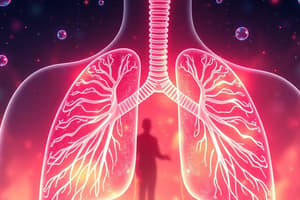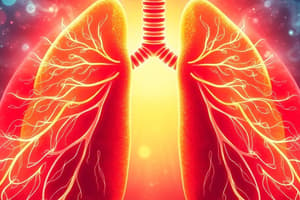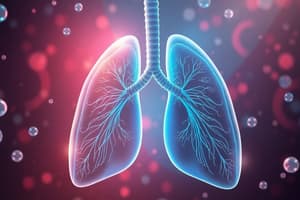Podcast
Questions and Answers
What is the primary mechanism of action for Beta 2 receptor agonists in the airway?
What is the primary mechanism of action for Beta 2 receptor agonists in the airway?
- Inhibiting the release of hypersensitivity mediators
- Binding to β2 receptors to cause smooth muscle relaxation (correct)
- Inhibiting the release of acetylcholine
- Stimulating increased secretion of mucus
Which of the following side effects is commonly associated with Beta 2 receptor agonists?
Which of the following side effects is commonly associated with Beta 2 receptor agonists?
- Dry mouth
- Tachycardia (correct)
- Headache
- Urinary retention
What is a precaution when using inhaled anticholinergics in patients?
What is a precaution when using inhaled anticholinergics in patients?
- Administering with antibiotics
- Avoiding use in elderly patients
- Using with high doses of corticosteroids
- Monitoring for urinary retention or BPH (correct)
Which of the following drugs is a Long Acting Beta Agonist (LABA)?
Which of the following drugs is a Long Acting Beta Agonist (LABA)?
What differentiates the pharmacokinetics of methylxanthines from Beta 2 agonists?
What differentiates the pharmacokinetics of methylxanthines from Beta 2 agonists?
Which delivery form of inhaled medications has the longest duration of action?
Which delivery form of inhaled medications has the longest duration of action?
What is a common side effect of methylxanthines such as theophylline?
What is a common side effect of methylxanthines such as theophylline?
Which inhaled anticholinergic is classified as a Long Acting Muscarinic Antagonist (LAMA)?
Which inhaled anticholinergic is classified as a Long Acting Muscarinic Antagonist (LAMA)?
What is the duration of action for a Short Acting Beta Agonist (SABA)?
What is the duration of action for a Short Acting Beta Agonist (SABA)?
Which of the following is a side effect associated with inhaled anticholinergics?
Which of the following is a side effect associated with inhaled anticholinergics?
Which important monitoring aspect should be considered when prescribing methylxanthines?
Which important monitoring aspect should be considered when prescribing methylxanthines?
Which delivery system provides the longest duration of action among Beta 2 receptor agonists?
Which delivery system provides the longest duration of action among Beta 2 receptor agonists?
Inhaled anticholinergics inhibit acetylcholine by blocking which type of receptors?
Inhaled anticholinergics inhibit acetylcholine by blocking which type of receptors?
Which of the following medications is classified specifically as a Short Acting Muscarinic Antagonist (SAMA)?
Which of the following medications is classified specifically as a Short Acting Muscarinic Antagonist (SAMA)?
What is a main pharmacokinetic characteristic of methylxanthines like theophylline?
What is a main pharmacokinetic characteristic of methylxanthines like theophylline?
Which receptor is primarily targeted by Long Acting Muscarinic Antagonists (LAMA) in the treatment of COPD?
Which receptor is primarily targeted by Long Acting Muscarinic Antagonists (LAMA) in the treatment of COPD?
What is a primary consequence of blocking histamine-2 receptors on gastric parietal cells?
What is a primary consequence of blocking histamine-2 receptors on gastric parietal cells?
Which adverse effect is mainly associated with cimetidine among H2 receptor antagonists?
Which adverse effect is mainly associated with cimetidine among H2 receptor antagonists?
Which condition should lead to the avoidance of long-term use of H2 receptor antagonists?
Which condition should lead to the avoidance of long-term use of H2 receptor antagonists?
What is an adverse effect of using metoclopramide for GERD treatment?
What is an adverse effect of using metoclopramide for GERD treatment?
What is the primary goal of therapy for peptic ulcer disease (PUD)?
What is the primary goal of therapy for peptic ulcer disease (PUD)?
What is a key characteristic of proton pump inhibitors (PPIs) compared to H2 receptor antagonists?
What is a key characteristic of proton pump inhibitors (PPIs) compared to H2 receptor antagonists?
In what situation should H2 receptor antagonists be avoided during prescription?
In what situation should H2 receptor antagonists be avoided during prescription?
Which of the following is NOT an effect of histamine-2 receptor antagonists?
Which of the following is NOT an effect of histamine-2 receptor antagonists?
Patients with which condition should have their vitamin B12 levels monitored during long-term use of H2 receptor antagonists?
Patients with which condition should have their vitamin B12 levels monitored during long-term use of H2 receptor antagonists?
What is the primary mechanism of action for inhaled corticosteroids?
What is the primary mechanism of action for inhaled corticosteroids?
Which of the following groups of medications is primarily aimed at managing bronchoconstriction associated with COPD?
Which of the following groups of medications is primarily aimed at managing bronchoconstriction associated with COPD?
What side effect is commonly associated with leukotriene receptor antagonists like Montelukast?
What side effect is commonly associated with leukotriene receptor antagonists like Montelukast?
In patients with what condition should inhaled anticholinergics be used with caution?
In patients with what condition should inhaled anticholinergics be used with caution?
Which pharmacokinetic characteristic is associated with methylxanthines like theophylline?
Which pharmacokinetic characteristic is associated with methylxanthines like theophylline?
What is the target receptor type for antihistamines?
What is the target receptor type for antihistamines?
Which of the following medications is a first-generation antihistamine?
Which of the following medications is a first-generation antihistamine?
What is a clinically relevant precaution when using high-dose inhaled corticosteroids in children?
What is a clinically relevant precaution when using high-dose inhaled corticosteroids in children?
Which of the following actions do decongestants primarily have on the nasal mucosa?
Which of the following actions do decongestants primarily have on the nasal mucosa?
What is the mechanism of action for expectorants like guaifenesin?
What is the mechanism of action for expectorants like guaifenesin?
What should patients be cautious about when using codeine as an antitussive?
What should patients be cautious about when using codeine as an antitussive?
Which potential side effect can arise from overuse of topical decongestants?
Which potential side effect can arise from overuse of topical decongestants?
Which of the following is a characteristic of long-acting beta agonists (LABA)?
Which of the following is a characteristic of long-acting beta agonists (LABA)?
What is a common side effect of diuretics?
What is a common side effect of diuretics?
Which type of diuretic is used for longer-lasting effects with less diuresis?
Which type of diuretic is used for longer-lasting effects with less diuresis?
What condition are expectorants not recommended for?
What condition are expectorants not recommended for?
Which adverse effect is specifically associated with aldosterone antagonists?
Which adverse effect is specifically associated with aldosterone antagonists?
What mechanism do osmotic laxatives use to promote bowel movements?
What mechanism do osmotic laxatives use to promote bowel movements?
What is a key precaution when taking magnesium-containing laxatives?
What is a key precaution when taking magnesium-containing laxatives?
What adverse effect may occur with stimulant laxatives during pregnancy?
What adverse effect may occur with stimulant laxatives during pregnancy?
What can excessive use of laxatives potentially lead to?
What can excessive use of laxatives potentially lead to?
What is the primary action of aldosterone antagonists?
What is the primary action of aldosterone antagonists?
What is a significant side effect of opioid receptor antagonists used for constipation?
What is a significant side effect of opioid receptor antagonists used for constipation?
Which laxative class acts by combining with water to mimic dietary fiber?
Which laxative class acts by combining with water to mimic dietary fiber?
What common effect do both osmotic and stimulant laxatives share?
What common effect do both osmotic and stimulant laxatives share?
Which diuretic type primarily inhibits sodium reabsorption in the ascending loop of Henle?
Which diuretic type primarily inhibits sodium reabsorption in the ascending loop of Henle?
What is a potential risk of using bismuth subsalicylate in children with viral conditions?
What is a potential risk of using bismuth subsalicylate in children with viral conditions?
What is a critical consideration for prescribing diphenoxylate and difenoxin?
What is a critical consideration for prescribing diphenoxylate and difenoxin?
Which of the following drugs is a mu and kappa opioid receptor agonist?
Which of the following drugs is a mu and kappa opioid receptor agonist?
What adverse effect is associated with the phenothiazines used as antiemetics?
What adverse effect is associated with the phenothiazines used as antiemetics?
Which adverse effect should be monitored when using cannabinoids for nausea and vomiting?
Which adverse effect should be monitored when using cannabinoids for nausea and vomiting?
For which condition is Alosetron specifically indicated?
For which condition is Alosetron specifically indicated?
What is a significant interaction concern with the use of Substance P/neurokinin 1 receptor antagonists?
What is a significant interaction concern with the use of Substance P/neurokinin 1 receptor antagonists?
What is a primary action of 5-HT3 receptor antagonists?
What is a primary action of 5-HT3 receptor antagonists?
Which of the following should be avoided when prescribing anticholinergics like scopolamine?
Which of the following should be avoided when prescribing anticholinergics like scopolamine?
What is a common adverse effect of 5-HT3 receptor antagonists?
What is a common adverse effect of 5-HT3 receptor antagonists?
What condition would contraindicate the use of phenothiazines?
What condition would contraindicate the use of phenothiazines?
What is an important precaution when using diphenhydramine in older adults?
What is an important precaution when using diphenhydramine in older adults?
Which of these conditions is a contraindication for using loperamide?
Which of these conditions is a contraindication for using loperamide?
What serious risk is associated with long-term use of phenothiazines?
What serious risk is associated with long-term use of phenothiazines?
What is the primary goal of GERD therapy?
What is the primary goal of GERD therapy?
Which of the following is a nonpharmacologic therapy for GERD?
Which of the following is a nonpharmacologic therapy for GERD?
Which class of drugs is considered first-line therapy for frequent GERD symptoms?
Which class of drugs is considered first-line therapy for frequent GERD symptoms?
What is a common adverse effect of magnesium-based antacids?
What is a common adverse effect of magnesium-based antacids?
What is a potential long-term effect of proton pump inhibitor use?
What is a potential long-term effect of proton pump inhibitor use?
In which condition is the use of calcium-based antacids contraindicated?
In which condition is the use of calcium-based antacids contraindicated?
What is one of the clinical uses for histamine-2 receptor antagonists (H2RAs)?
What is one of the clinical uses for histamine-2 receptor antagonists (H2RAs)?
What may be a serious potential adverse effect of prokinetic agents?
What may be a serious potential adverse effect of prokinetic agents?
Which lifestyle modification can help prevent GERD symptoms?
Which lifestyle modification can help prevent GERD symptoms?
Why should antacids not be used as monotherapy for significant disease?
Why should antacids not be used as monotherapy for significant disease?
What is a common side effect of proton pump inhibitors?
What is a common side effect of proton pump inhibitors?
Which action do proton pump inhibitors primarily perform?
Which action do proton pump inhibitors primarily perform?
What is a recommended action if GERD symptoms persist despite therapy?
What is a recommended action if GERD symptoms persist despite therapy?
What are antacids mainly used for?
What are antacids mainly used for?
Flashcards
Beta 2 Receptor Agonists
Beta 2 Receptor Agonists
These medications bind to beta 2 receptors in airway smooth muscle cells, triggering relaxation and bronchodilation by stimulating cyclic AMP. They also inhibit the release of hypersensitivity mediators, particularly from mast cells.
Beta 2 Agonists & Side Effects
Beta 2 Agonists & Side Effects
Beta 2 agonists can cause side effects like tachycardia and tremors due to their partial activity on beta 1 receptors.
Short-Acting Beta Agonists (SABA)
Short-Acting Beta Agonists (SABA)
SABA medications like Albuterol, Levalbuterol, and Pirbuterol provide rapid relief from bronchospasm for 4-6 hours.
Long-Acting Beta Agonists (LABA)
Long-Acting Beta Agonists (LABA)
Signup and view all the flashcards
Inhaled Anticholinergics - Mechanism
Inhaled Anticholinergics - Mechanism
Signup and view all the flashcards
Inhaled Anticholinergics - Side Effects
Inhaled Anticholinergics - Side Effects
Signup and view all the flashcards
Short-Acting Muscarinic Antagonists (SAMA)
Short-Acting Muscarinic Antagonists (SAMA)
Signup and view all the flashcards
Long-Acting Muscarinic Antagonists (LAMA)
Long-Acting Muscarinic Antagonists (LAMA)
Signup and view all the flashcards
Beta 2 Receptor Agonists: Mechanism
Beta 2 Receptor Agonists: Mechanism
Signup and view all the flashcards
What are beta 2 receptor agonists?
What are beta 2 receptor agonists?
Signup and view all the flashcards
What are the side effects of beta 2 agonists?
What are the side effects of beta 2 agonists?
Signup and view all the flashcards
What are SABAs?
What are SABAs?
Signup and view all the flashcards
Give an example of SABA.
Give an example of SABA.
Signup and view all the flashcards
What are LABAs?
What are LABAs?
Signup and view all the flashcards
Give an example of LABA.
Give an example of LABA.
Signup and view all the flashcards
How do inhaled anticholinergics work?
How do inhaled anticholinergics work?
Signup and view all the flashcards
What are the common side effects of inhaled anticholinergics?
What are the common side effects of inhaled anticholinergics?
Signup and view all the flashcards
What are SAMAs?
What are SAMAs?
Signup and view all the flashcards
Give an example of SAMA.
Give an example of SAMA.
Signup and view all the flashcards
What are LAMAs?
What are LAMAs?
Signup and view all the flashcards
Give an example of LAMA.
Give an example of LAMA.
Signup and view all the flashcards
How do methylxanthines work?
How do methylxanthines work?
Signup and view all the flashcards
What are the side effects of methylxanthines?
What are the side effects of methylxanthines?
Signup and view all the flashcards
Expectorants
Expectorants
Signup and view all the flashcards
Expectorant Precautions
Expectorant Precautions
Signup and view all the flashcards
Diuretics: Primary Function
Diuretics: Primary Function
Signup and view all the flashcards
Diuretics: Blood Pressure Control
Diuretics: Blood Pressure Control
Signup and view all the flashcards
Diuretics: Classes
Diuretics: Classes
Signup and view all the flashcards
Diuretics: Side Effects
Diuretics: Side Effects
Signup and view all the flashcards
Diuretics: Low Potassium
Diuretics: Low Potassium
Signup and view all the flashcards
Loop Diuretics: Action
Loop Diuretics: Action
Signup and view all the flashcards
Thiazide Diuretics: Action
Thiazide Diuretics: Action
Signup and view all the flashcards
Aldosterone Antagonists: Role
Aldosterone Antagonists: Role
Signup and view all the flashcards
Laxatives: Types
Laxatives: Types
Signup and view all the flashcards
Laxatives: Risks
Laxatives: Risks
Signup and view all the flashcards
Antidiarrheals: Types
Antidiarrheals: Types
Signup and view all the flashcards
Antidiarrheals: Precautions
Antidiarrheals: Precautions
Signup and view all the flashcards
H2RAs: Action
H2RAs: Action
Signup and view all the flashcards
H2RAs: Adverse Effects
H2RAs: Adverse Effects
Signup and view all the flashcards
H2RAs: Pregnancy & Lactation
H2RAs: Pregnancy & Lactation
Signup and view all the flashcards
Metoclopramide: Uses
Metoclopramide: Uses
Signup and view all the flashcards
Bethanechol: Uses
Bethanechol: Uses
Signup and view all the flashcards
Antacids: Action
Antacids: Action
Signup and view all the flashcards
PUD: Goals of Therapy
PUD: Goals of Therapy
Signup and view all the flashcards
PPIs: Role in PUD
PPIs: Role in PUD
Signup and view all the flashcards
PUD: Importance of H. pylori Elimination
PUD: Importance of H. pylori Elimination
Signup and view all the flashcards
H2RAs vs. PPIs: Efficacy
H2RAs vs. PPIs: Efficacy
Signup and view all the flashcards
GERD Therapy Goals
GERD Therapy Goals
Signup and view all the flashcards
GERD Lifestyle Changes
GERD Lifestyle Changes
Signup and view all the flashcards
Antacids: What they do
Antacids: What they do
Signup and view all the flashcards
Antacids: Side Effects
Antacids: Side Effects
Signup and view all the flashcards
Proton Pump Inhibitors (PPIs): Function
Proton Pump Inhibitors (PPIs): Function
Signup and view all the flashcards
PPIs: Common Side Effects
PPIs: Common Side Effects
Signup and view all the flashcards
PPIs: Long-Term Concerns
PPIs: Long-Term Concerns
Signup and view all the flashcards
H2RAs: What they do
H2RAs: What they do
Signup and view all the flashcards
Prokinetic Agents: Use & Risk
Prokinetic Agents: Use & Risk
Signup and view all the flashcards
Antacid Use: Important Points
Antacid Use: Important Points
Signup and view all the flashcards
PPI Use: Important Points
PPI Use: Important Points
Signup and view all the flashcards
GERD Therapy: Ongoing Management
GERD Therapy: Ongoing Management
Signup and view all the flashcards
Key Points about GERD Therapy
Key Points about GERD Therapy
Signup and view all the flashcards
Diphenoxylate/Difenoxin
Diphenoxylate/Difenoxin
Signup and view all the flashcards
Loperamide
Loperamide
Signup and view all the flashcards
Eluxadoline
Eluxadoline
Signup and view all the flashcards
Alosetron
Alosetron
Signup and view all the flashcards
Dimenhydrinate, Diphenhydramine, Hydroxyzine, Meclizine
Dimenhydrinate, Diphenhydramine, Hydroxyzine, Meclizine
Signup and view all the flashcards
Prochlorperazine, Perphenazine, Promethazine
Prochlorperazine, Perphenazine, Promethazine
Signup and view all the flashcards
Dronabinol (Marinol)
Dronabinol (Marinol)
Signup and view all the flashcards
Palonosetron, Ondansetron, Dolasetron, Granisetron
Palonosetron, Ondansetron, Dolasetron, Granisetron
Signup and view all the flashcards
Scopolamine
Scopolamine
Signup and view all the flashcards
Aprepitant
Aprepitant
Signup and view all the flashcards
Trimethobenzamide
Trimethobenzamide
Signup and view all the flashcards
Antihistamines for Motion Sickness
Antihistamines for Motion Sickness
Signup and view all the flashcards
Phenothiazines: Adverse Effects
Phenothiazines: Adverse Effects
Signup and view all the flashcards
Cannabinoids: Adverse Effects
Cannabinoids: Adverse Effects
Signup and view all the flashcards
5-HT3 Antagonists: Cautions
5-HT3 Antagonists: Cautions
Signup and view all the flashcards
Study Notes
Beta 2 Receptor Agonists
- Mechanism of Action: Bind to β2 receptors on airway smooth muscle, stimulating relaxation and bronchodilation via the cyclic AMP pathway. Inhibit hypersensitivity mediator release, particularly from mast cells. Bind to β2 smooth muscle cells in the airway, stimulating relaxation causing bronchodilation via the cyclic AMP pathway. Inhibit release of hypersensitivity mediators especially from mast cells.
- Side Effects: Tachycardia, tremors, particularly due to some β1 receptor activity.
- Precautions: Monitor patients with arrhythmias, cardiovascular disease, or hyperthyroidism.
- Types:
- Short-Acting Beta Agonists (SABA): 4-6 hours duration. Examples include albuterol (Proair, Ventolin, Proventil), levalbuterol (Xopenex), pirbuterol (Maxair), and tirbutaline (Brethine).
- Long-Acting Beta Agonists (LABA): 12 hours duration. Examples include salmeterol (Serevent), formoterol (Foradil), and arformoterol (Brovana).
- Ultra-Long-Acting Beta Agonists (ULABA): 24 hours duration. Examples include indacaterol (Arcapta Neohaler), olodaterol (Striverdi Respimat), and vilanterol (Breo Ellipta, only in combination with ICS).
- Pharmacokinetics: Absorbed from the bronchi, metabolized in the liver, and excreted in the urine. Available in various forms and delivery systems.
Inhaled Anticholinergics
- Mechanism of Action: Block muscarinic cholinergic receptors, preventing acetylcholine from binding and causing bronchoconstriction. Reduces cyclic GMP formation, leading to decreased smooth muscle contractility. Block muscarinic cholinergic receptors by antagonizing acetylcholine. Decreases formation of cyclic GMP, reducing smooth muscle contractility of the lungs.
- Pharmacokinetics: Poorly absorbed from the lungs and GI tract. 90% excreted in feces, 10% metabolized by hydrolysis.
- Side Effects: Dry mouth, cough, headache.
- Precautions: Avoid in patients with urinary retention, BPH, or angle-closure glaucoma. Not for acute bronchospasm unless combined with albuterol.
- Types:
- Short-Acting Muscarinic Antagonists (SAMA): 4-6 hours duration. Example: ipratropium bromide (Atrovent) and ipratropium bromide/albuterol (Combivent).
- Long-Acting Muscarinic Antagonists (LAMA):
- 24 hours duration: Tiotropium bromide (Spiriva Handihaler or Respimat), Umeclidinium bromide (Incrue Ellipta).
- 12 hours duration: Aclidinium bromide (Tudorza Pressair).
- 24 hours duration (nebulized): Revefenacin (Yupelri).
- Glycopyrronium bromide (Seebri Neohaler): 12 hours duration
- Glycopyrrolates preferentially bind to M3 receptors involved in COPD, affecting bronchoconstriction.
- Combinations: Breztri (LAMA + LABA + ICS)
Methylxanthines
- Mechanism of Action: Inhibit phosphodiesterases, increasing cyclic AMP, relaxing bronchial smooth muscle and pulmonary vessels.
- Representative Drug: Theophylline
- Pharmacokinetics: Well absorbed orally, low first-pass metabolism, metabolized in the liver.
- Side Effects: Headache, irritability, gastric irritation, nausea/vomiting.
- Precautions: Frequent drug interactions. Requires serum drug level monitoring to prevent toxicity.
Studying That Suits You
Use AI to generate personalized quizzes and flashcards to suit your learning preferences.
Related Documents
Description
This quiz covers the mechanism of action, side effects, and types of beta 2 receptor agonists. You will also learn about short-acting, long-acting, and ultra-long-acting options and important precautions for their use. Test your knowledge of these crucial medications in respiratory therapy.




